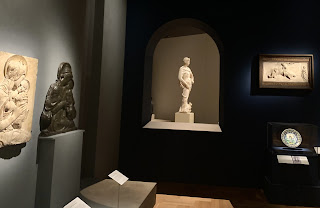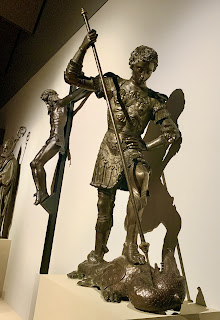Given the intensity of our cultural sightseeing across the three weeks we spent in Japan in 2019, I didn’t rush to get to The Queen’s Gallery at Buckingham Palace for Japan: Courts and Culture. That was a mistake. I imagined the royal family’s stuff couldn’t be that different than what’s on display at top Japanese museums. I was wrong.

It’s not the kinds of objects that differ, but their quality. All the things you’d expect to see in any Japanese exhibition are here: Samurai arms and armour, lacquer boxes and furniture, delicate porcelains, beautiful screens, exquisite prints. Everything was either acquired by a royal for his or her personal collection, or received as a gift from either the government or … more often … the imperial family. In the period between the commercial opening of Japan in 1853 and the beginning of WWII, both countries were empires with an exalted opinion of themselves and each fancied the other their match on the other side of the world. The gift giving was prodigious.
Of course, as any fan of Japanese culture knows, it’s more about elegance and craftsmanship than bling. So what you get here in four tasteful galleries is a subset of art and craft that exemplifies tasteful perfection. It’s all breathtakingly beautiful, one of a kind and manages to pull off that Japanese trick of being both simple and complex.
Britain’s fascination with Japan is an old one. The most striking piece in the first gallery is a set of armour sent as a diplomatic gift by the newly-established Tokugawa shogunate to King James I and VI. It’s hard, in our diverse and variety laden world, to imagine just how alien that beautiful but menacing costume must have been in Renaissance England. Given the age’s love of the exotic, and James’ love of both showing off and of beautiful things, I suspect he adored it. More intriguing, if you can tear your brain away from the sinuously writhing dragons, the spectacular flared helmet and the silk needlework that makes the arm covers look a bit like feathered wings, is the contemplation of what this could have meant. It invited trade. Had the country not changed its mind 20 years later, how might British trade and expansion have changed?
The Tokugawa armour was a false start in international relations, however, and from the 1630s to 1868 the British royals were just like everyone else. They had to buy from Dutch traders, the only Europeans the Japanese let in during their time of isolation. (The Dutch, thought the Japanese, so obviously put money above religion or making social judgments that they didn’t bring the risk of cultural contamination other Europeans threatened.) Seeing the spectacular pieces of porcelain Queen Mary I brought into the collection, you have to wonder if the fact she was Queen of the Netherlands before taking the British throne put her at the head of the shopping queue.

The most profligate collector, however, is the same spendthrift who usually takes that title in these galleries: good old George IV. Unfortunately, George was splashing the cash when Europeans just couldn’t stop themselves from blinging their oriental collectibles up with French ormolu mounts. They were thought to make the items even more precious. While it’s interesting to see how European craftsmen played off the Japanese foundations, and what they created was masterful, they almost always take away from the allure of the original.
While purchased collections brought in some wonders, it’s the re-opening of Japan … and the Imperial gift giving that goes with it … that move to jaw dropping territory.
There’s more armour here, three sets each wonderfully different from the other in their intricate decorative schemes. A set of spears is black lacquer inlaid with chips of mother of pearl; the effect in a procession on a sunny day must have been incredible. Lacquer display cabinets are mind-boggling in the complexity of their creation, but pale to insignificance before a glass bowl created using a cloisonné technique to separate the powdered glass into panels, but then using chemicals to dissolve the wires so you’re left with a translucent, patterned object that seems impossible in its creation.
There are ceremonial swords aplenty, as beautiful for the patterns and fire in their steel blades as for the ornate hilts, scabbards and presentation boxes. Throughout these objects, however, what is ornate is also generally small and subtle. I regretted deeply not having reading glasses to help me study the fine points.
Like all the best gifts, many things here combined utility with an outrageous luxury you’d probably not lavish on yourself. The delicate mother of pearl, bamboo and gold fans. The subtly-patterned writing set and lap desk with a variety of bits and pieces that entice you to take up Japanese calligraphy just to learn how to use them. Most intriguing, an “incense game”, packaged in yet another purpose-built lacquer box with customised trays and compartments to hold all the kit. A master of ceremonies lit different bits of incense and challenged players to identify the smell, much as you can do today with sets that help to identify different essences in wine. A variety of small implements for preparing the incense made it clear some expertise was needed to run the game. I was a bit sad to see that the set appears never to have been used, all of the blocks of incense still carefully wrapped in their tidy packaging.

The curators save the best for last. Just before the exit you’re confronted with two extraordinary screens. Choosing between them, should someone offer you one, would be painful as both are beguilingly beautiful … but in completely different ways.
The first, a gift for Queen Victoria’s Diamond Jubilee, is an almost monochrome study in browns. It’s a scene of mountains, rocks and water, both wild and soothing. There are hints of brownish green in the mountains, and brownish red in the autumnal trees, but the whole scene manages to stay within one colour palette yet be completely realistic. From a distance it’s an almost impressionistic landscape. Up close, you realise tiny houses, crags and trees are all worked in such detail that a few square inches could be cut out and displayed as a precious miniature. It’s so real you feel yourself falling into the landscape, like the children in The Dawn Treader heading back to Narnia through the painting in the guest room.
The other screen, a coronation gift to Edward VII, uses all the colour not deployed in the mountain scene. Here are birds, trees and flowers in riotous profusion, with one screen for each of the four seasons. Peacocks preen, cranes strut, exotic ducks and pheasants show off plumage unknown in the West, surrounded by billows of peonies, cherry blossom, quince and more. It’s as if the residents of Birdland were let loose at the Chelsea Flower Show.
Both screens are masterworks of embroidery, so detailed that at a distance you think they’re painted. Up close, you can admire how the use of different threads, materials and techniques creates different visual effects. Usually, by the time you get to the end of an exhibition you’re a bit jaded by the wonders and might walk quickly past the last items. Here, they are worth the price of admission for the whole show.
One of the beauties of The Queen’s Gallery is that you can get your admission ticket validated for use for return visits for the next year, which means you can usually take in two exhibitions on one ticket, with all the return visits you wish. I’m already wondering if I might be able to get back before the show closes. I don’t usually invest in exhibition catalogues but couldn’t resist this one. (It was on sale!) Browsing through reveals a good many items that didn’t even register in my brain, so overwhelmed was I by all the beauty.
If you want to drink in these wonders of Japan, make it quick, the show closes on 26 February, after which the items will return to their usual places throughout the Royal palaces.
For more stories on Japan, please see the index “The Joys of Japan” in the right column of this blog. It lists all of my coverage from our trip in 2019, with links. Note the 3-column layout doesn’t come up if you’re viewing on a mobile device.







